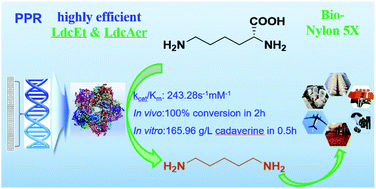Advances in bio-nylon 5X: discovery of new lysine decarboxylases for the high-level production of cadaverine†
Abstract
Cadaverine (1,5-pentanediamine) is the most important precursor for nylon PA5X, which has an extremely competitive market due to the high consumption of engineered plastics and fibers. The key enzyme lysine decarboxylase is in desperate need for industrial bio-based cadaverine production. In this study, new lysine decarboxylases have been mined by peptide pattern recognition for the high-level production of cadaverine. The predicted enzymes were expressed in E. coli and analyzed as whole-cell biocatalysts. Two outstanding recombinant enzymes from Edwardsiella tarda and Aeromonas sp. (LdcEt and LdcAer, respectively), were further purified and characterized. The optimal pH and temperature for LdcEt and LdcAer were pH 7, 55 °C and pH 6, 50 °C, respectively. These two enzymes were stable over the pH range of 5–7 during 24 h incubation. Both of them still had activity after being incubated at pH 8. LdcEt and LdcAer also have good thermostability with a half-life of 14.5 h and 20.3 h at 60 °C, respectively. The kinetic analysis showed that they have high catalytic efficiency as the kcat/Km (LdcEt: 243.28 s−1 mM−1; LdcAer: 266.86 s−1 mM−1) was the highest when compared for all the related studies. The whole cell conversion by LdcEt with 0.1% (v/v) Triton X-100 can convert 100% 2 M L-lysine HCl to cadaverine in 2 h and the cadaverine productivity was high up to 103.47 ± 4.37 g L−1 h−1. The in vitro studies further found that unpurified cell-lysates of LdcEt had relatively higher activity compared to the whole cell conversion. Meanwhile, 0.4 mg mL−1 purified LdcEt and LdcAer can efficiently produce 165.96 ± 1.41 g L−1 and 155.84 ± 4.63 g L−1 cadaverine only in 0.5 h, respectively. The high specific activity, pH, thermo-stability, and catalytic efficiency in vivo and in vitro, combined with simultaneous cell treatment with Triton X-100 and the bioconversion process, provide LdcEt with great potential in the economic and efficient production of cadaverine at the industrial scale.



 Please wait while we load your content...
Please wait while we load your content...